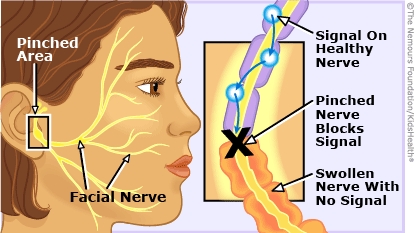A to Z: Bell’s Palsy

May also be called: Facial Palsy
Bell’s palsy is a sudden but usually temporary weakness or paralysis of the muscles on one side of the face.
More to Know
Everyone has two facial nerves, one on each side of the head, that carry messages from the brain to the face. These messages may tell an eyelid to close, one side of the mouth to smile or frown, or salivary glands to make spit.
With Bell’s palsy, one of the facial nerves swells and gets compressed as it passes through a small hole at the base of the skull. The compressed nerve can’t send messages correctly, resulting in weakness or temporary paralysis on one side of the face.
Some people with Bell’s palsy have only slight weakness; others may not be able to move that side of their face at all. Other symptoms may include headaches, a drooping or sagging appearance on the affected side of the face, and difficulty fully shutting one eye.

Bell’s palsy is most often associated with a viral infection, but it can also be related to ear infections, bad colds, or trauma to the head or face. Usually, the virus or infection that leads to Bell’s palsy has passed, so often there’s no specific treatment for the condition. It goes away once the swelling of the nerve goes down and the nerve recovers from any damage.
In some cases, doctors can give medicine such as steroids to help reduce the swelling, or prescribe an eye patch or eye drops if the person’s eye is dry. Lyme disease is a common cause of Bell’s palsy, and treatment with antibiotics is recommended in these cases.
Keep in Mind
Bell’s palsy should be diagnosed and evaluated by a doctor. Most people with Bell’s palsy recover fully within 1 to 3 months with or without treatment, although some may have permanent weakness in their face afterward.
All A to Z dictionary entries are regularly reviewed by KidsHealth medical experts.
